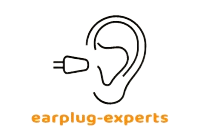If you incorporate earplugs into your daily routine, whether it’s for sleeping, swimming, or simply to block out ambient noise, you might encounter challenges in correctly inserting them into your ears. With the wide variety of earplugs available on the market, each serving different purposes and made from various materials such as foam, silicone, or wax, knowing how to use them correctly is essential. Additionally, different earplugs come in various shapes, tailored for specific uses. Learning how to use earplugs based on their type will ensure comfortable wear without causing discomfort to your ears.
To properly use earplugs, follow these simple steps:
Clean your hands thoroughly to avoid introducing any dirt or bacteria into your ears.
Roll the earplug of your choice into a small, manageable shape using your fingers. This helps prepare the plug for insertion.
Gently lift one ear up with one hand while holding the earplug with the other hand. With the ear canal exposed, insert the rolled-up earplug into the ear canal by gently rolling it up further.
Hold the earplug in place until it comfortably fits into your ear canal, effectively blocking out external sounds.
By following these steps, you can ensure that your earplugs are correctly inserted and positioned, providing you with the intended benefits of noise reduction or water protection, depending on the type of earplugs you choose.
Now, let’s dive into the specifics of how to properly wear different types of earplugs, ensuring you get the most out of each one depending on your needs.
How to insert foam earplugs?
Foam earplugs have earned a special place in my heart when it comes to ensuring a peaceful and comfortable sleep. Their unique design allows them to expand perfectly within the ear canal, providing a custom fit that effectively blocks out noise without causing any discomfort. However, if not properly inserted, foam earplugs can sometimes misbehave and expand in ways that lead to an unpleasant experience. But don’t worry! I’ve got you covered with a simple step-by-step guide on how to insert foam earplugs correctly:
1- Clean your hands
Before you even think about using your earplugs, take a moment to ensure your hands are squeaky clean. It may sound like a simple step, but it’s one that can make a big difference in your overall ear health and hygiene.
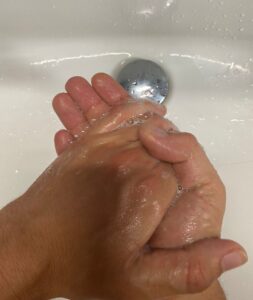
2- Roll the foam into a small form
Now, here’s a crucial technique that will make using foam earplugs a breeze. Before you insert the foam earplugs into your ear, it’s essential to give them a little TLC and shape them properly. Here’s how you do it:
Take the foam earplug between your two fingers and gently roll it back and forth. Imagine you’re forming a cute little snake-like shape with the foam. This simple step is key to ensuring a snug fit in your ear canal.

3- Pull your ear up and back
Now, let’s move on to the next step in our quest for the perfect foam earplug experience. It’s time to get a little hands-on!
Using one hand, gently pull your ear up and back. This action stretches your ear canal slightly, making it easier to insert the earplug comfortably. With your other hand, take the rolled-up foam earplug and gently insert it into the ear canal.
As you insert the earplug, continue to roll it up repeatedly to ensure it fits snugly in your ear. Remember not to pull your ear up and back too forcefully; a gentle stretch is all you need for the best fit.

4- Insert the foam earplug into your ear canal
Using one hand, gently pull your ear up and back. This action stretches your ear canal slightly, making it easier to insert the earplug comfortably. With your other hand, take the rolled-up foam earplug and gently insert it into the ear canal.
As you insert the earplug, continue to roll it up repeatedly to ensure it fits snugly in your ear. Remember not to pull your ear up and back too forcefully; a gentle stretch is all you need for the best fit.
This step is especially valuable for those with smaller ears, who may find it tricky to insert earplugs properly. By gently pulling your ear up and back, you create a more accommodating path for the foam earplug to settle in comfortably.

5- Hold the foam earplug in place for 30 sec.
Now that you’ve inserted the foam earplug into your ear canal, the next crucial step is to allow it to properly expand. This expansion is what creates a custom fit and ensures the earplug effectively blocks out external noise.
With the foam plug securely positioned in your ear canal, gently hold it in place with one finger, making sure it doesn’t come loose. Once you’ve got a good grip on the earplug, take a moment to relax and let the foam work its magic.
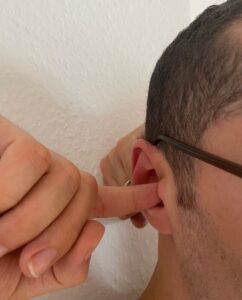
6- Test If earplug is working
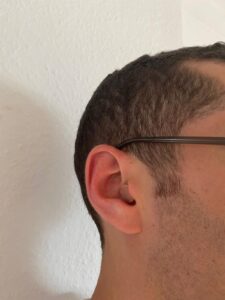
How to insert Silicone and Wax earplugs
Silicone and wax earplugs are popular choices for noise reduction and comfortable wear. They come in small ball-shaped forms that can be custom-fitted to your ear canal, ensuring a snug and secure fit. Here are some tips on using silicone and wax earplugs effectively:
1- Clean your hands
Make sure that your hands are always clean. Because you need to soften them with your fingers. To avoid dirt and germs, I always make sure to wash my hands before I use any earplugs.
2- Soften the wax or silicone earplug in your hand
Silicone or wax earplugs are commonly used and come in a small ball shape, designed to fit individually in your ears for a comfortable experience. To use them, first, you need to soften them by enclosing the earplug in your hand for about 30 seconds. This step is important to make the material more pliable and easier to shape. Once softened, mold the earplug to fit your ear canal. Then, gently insert the earplug into your ear and ensure it forms a proper seal to block out noise effectively. Repeat the process for the other ear if using a pair of earplugs. By following these steps, you can enjoy the benefits of a custom fit and enhanced noise reduction for a peaceful environment.
3- Shape the earplug into a cone
When using wax or silicone earplugs, an important step is to mold them into the shape of a cone. Take the earplug between your thumb and forefinger and shape it into a rounded cone. This molded shape will ensure a perfect fit in your ear canal, maximizing their effectiveness. Once the earplug has been properly shaped, it is ready to be used for noise reduction and a comfortable wearing experience.
4- Keep your hair out with one hand
Moldable wax and silicone earplugs have a slightly sticky texture, which can also cause them to adhere to your hair. If you have long hair around your ears, it is recommended to hold it back with one hand while inserting the earplugs. This prevents the earplugs from getting entangled in your hair, making the process of insertion much easier and hassle-free.
5- Insert the earplug
Insert the earplug into your ear canal until it fills it comfortably. You should feel that it fits snugly and effectively blocks out as much noise as possible. When inserted correctly, your voice should sound muffled. If you notice that the largest parts of the earplug are sticking out of your ear, it means you have not inserted it properly. In such a case, the earplug will not provide a good seal against noise, and you should adjust it until the largest part is securely placed inside the ear canal.
How to insert reusable earplugs
Reusable earplugs come pre-shaped and are available in various sizes, which can make them a bit tricky to use if you have a larger ear size. Additionally, they are designed in different shapes to cater to specific purposes such as sleeping or swimming. Therefore, it’s essential to determine which model of reusable earplugs will fit you best before making a purchase. Knowing the right size and shape for your needs will ensure a comfortable and effective experience with these earplugs.
Here are the steps on how to insert reusable earplugs:
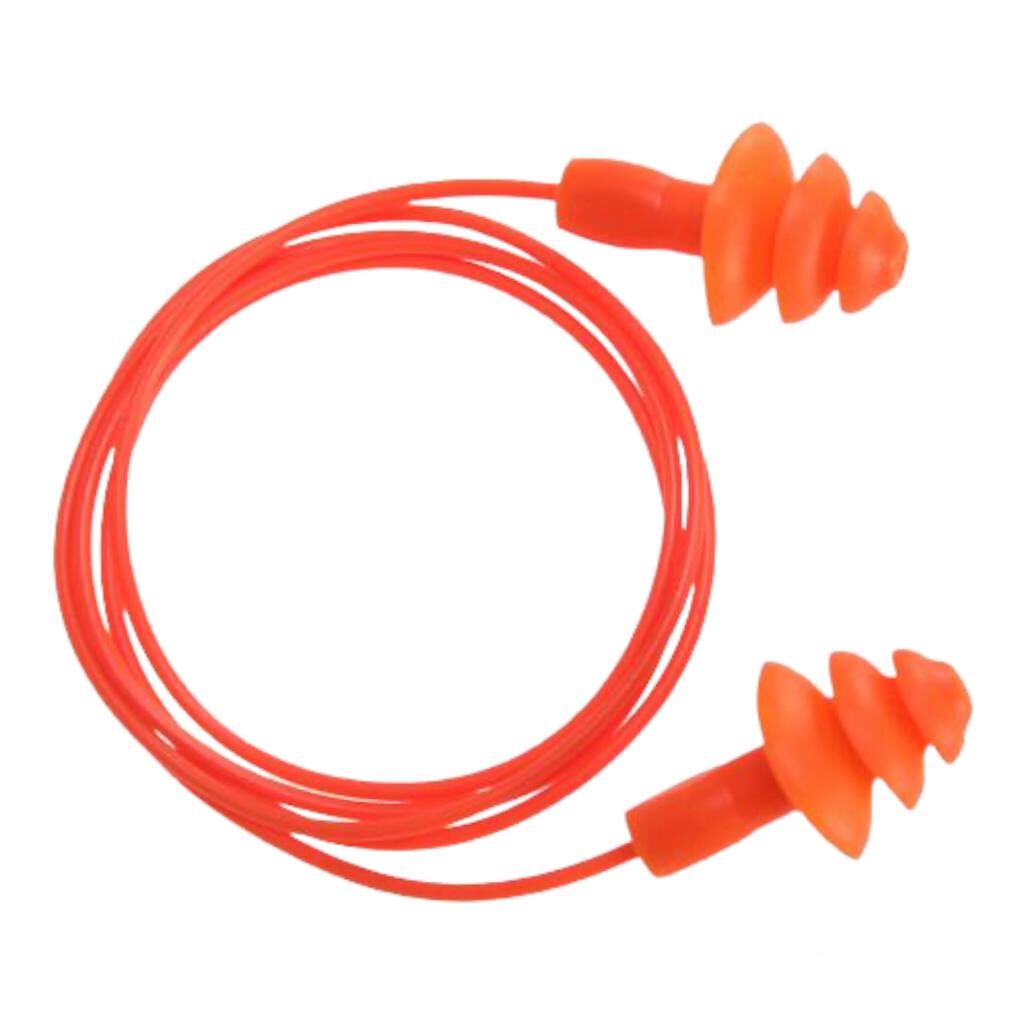
1- Have the right size of reusable earplugs
Reusable earplugs are pre-molded into various sizes, allowing users to choose the one that best fits their ears. If you’re already familiar with these earplugs and know your size, it’s recommended to opt for that size. However, if you’re unsure about the size to buy, going for the “one size fits all” option might be a practical approach. By using this type, you can gauge how well it fits your ears and make adjustments accordingly.
For those with average-sized ears, standard sizes should work just fine. But if you’re uncertain, you can experiment with different sizes. Try using each size for a day to see which one provides the most comfortable and secure fit. This way, you can find the perfect fit that ensures a pleasant experience with your reusable earplugs.
2- Pull your ear up and back with one hand
When inserting the earplug, use one hand to gently pull the top of your ear upward. This action helps to straighten your ear canal, making it easier for the earplug to slide in comfortably. By straightening the ear canal, you create a smoother pathway for the earplug, ensuring a better fit and improved effectiveness in blocking out unwanted noise. So, remember to use this simple technique to facilitate the insertion of your earplugs and enhance your overall experience.
3- Insert the plug by rolling it
Using your opposite hand, gently insert the reusable earplug into your ear canal by rolling it between your fingers. Ensure a slow and steady insertion until the earplug comfortably fits inside your ear canal.
Avoid pushing the earplug too far into your ear canal; it doesn’t need to be fully seated. Leave some small parts of the earplug outside the canal so that you can easily remove it later when needed. This proper positioning ensures a secure and comfortable fit, allowing you to wear the earplugs for extended periods without discomfort. Remember, finding the right balance is essential for both effectiveness and comfort while using reusable earplugs.
4- Test the reusable earplug
Once you have inserted the reusable earplug, it’s essential to test its effectiveness. Try speaking out loud or making some noise. If you notice that your voice sounds muffled, it’s a positive indication that the earplug is doing its job and effectively blocking out external noise.
On the other hand, if you can still clearly hear the noise around you, it might suggest that you have either chosen the wrong type of earplug or the wrong size for your ears. In such cases, you may want to try different models or sizes until you find the one that fits securely and provides the desired noise reduction.
Remember, finding the right earplug fit is crucial for ensuring optimal performance and a comfortable experience. So, don’t hesitate to experiment with different options until you discover the perfect fit for your ears.
How to remove your earplugs?
Removing your earplugs is a straightforward process and much easier than putting them in. To take them out, gently hold your ear up with the opposite hand and give them a slight twist as you pull them out of your ear canal.
When the earplugs are the correct size and fit for your ears, you shouldn’t experience any pain or discomfort while removing them. After you’ve taken out the earplugs, it’s a good idea to check if you feel any pain or soreness in your ears. This can help you determine whether the earplugs are fitting properly or not. Properly fitted earplugs should not cause any pain during removal.
Keep in mind that if you wear your earplugs for an extended period, you may feel some mild discomfort after removing them. This can be a sign that it’s time to replace your earplugs with new ones. Reusable earplugs may lose their effectiveness over time and might not provide the same level of noise reduction as when they were new.
By following these steps and guidelines, you can ensure that you are using your earplugs correctly, providing you with a comfortable and effective solution for blocking out unwanted noise in various situations.
What should you do before inserting earplugs?
Before inserting earplugs, there are several important steps to follow for a comfortable and effective experience. If your earplugs come in different sizes, ensure that you have the correct size that fits your ears properly. This will enhance the comfort and effectiveness of the earplugs when in use.
It is crucial to maintain clean hands before handling earplugs, especially in work environments where it may be challenging to wash your hands frequently. Neglecting to clean your hands can introduce dirt and germs into your ears, which can potentially cause harm. Therefore, do not underestimate the importance of this step and always ensure your hands are clean before handling earplugs.
For reusable earplugs, take the time to wipe them off before insertion. Keeping them clean temporarily is essential for maintaining their functionality and ensuring a hygienic use.
How far should earplugs go in?
When inserting the earplug into the ear canal, it is essential to ensure that only the major part of the earplug seals the canal. Avoid pushing it too far in, and leave some parts out for easy removal later.
It is important to remember that there is no need to insert the earplugs too deeply. They are designed to block out noise effectively when inserted properly. Inserting the plugs too far can potentially cause damage to the ear or result in an uncomfortable experience while using them.
If you are unsure about the correct insertion method, you can always refer to the steps mentioned above for guidance. By following these instructions, you can confidently insert the earplugs, guaranteeing a comfortable and secure fit while enjoying noise reduction benefits during sleep, work, or other activities.
How do I know if my earplugs are in correctly?
After inserting the earplugs, it is essential to test their effectiveness. To do so, speak loudly and observe if you hear your voice muffled or not. If your voice sounds muffled, it indicates that you have inserted the earplugs correctly and they are providing the desired noise reduction.
The muffled sound indicates that the earplugs are sealing the ear canal adequately, effectively blocking out external noises and providing the intended level of protection. This test ensures that you can confidently rely on your earplugs to create a quieter and more comfortable environment while sleeping, working, or engaging in any activity that requires noise reduction.
Why do my ears hurt after wearing earplugs?
Experiencing pain in the ear canals after inserting the earplugs is a clear indication that they have not been properly inserted. If the earplugs do not seal well or are pushed in too far, they can exert strong pressure on the ear canals, leading to discomfort and pain over time.
If you encounter such discomfort, it is essential to remove the earplugs immediately. Then, carefully follow the appropriate steps outlined earlier based on your earplug type to ensure proper insertion. By following the correct method, you can create a comfortable fit and ensure that the earplugs effectively block out unwanted noise without causing any pain.
However, if you still experience severe pain even after correctly inserting the earplugs, it is likely that you are using the wrong size earplugs for your ear canal. In such cases, it is advisable to try a different size or consider consulting a professional to find the most suitable earplugs that provide a comfortable and secure fit. Your safety and comfort are paramount, and choosing the right earplugs is crucial for achieving the desired level of noise reduction without causing any discomfort
